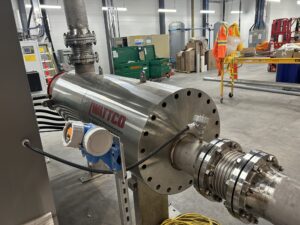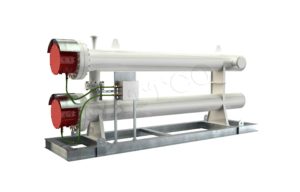How to Choose and Install Flanged Circulation Heaters
Last updated on April 3rd, 2024 at 04:43 pm
 Industrial heaters have played a very important role in various manufacturing industries. For example, a flanged heater is a popular immersion circulation heater that continuously heats liquids used during industrial processing.
Industrial heaters have played a very important role in various manufacturing industries. For example, a flanged heater is a popular immersion circulation heater that continuously heats liquids used during industrial processing.
They consist of many cylindrical heating elements that are electrically connected and arranged in the shape of a flange. Industry professionals typically use flanged circulation heaters to heat liquids like water, chemical solvents, oil, gases, and corrosive solutions. They are vital to maintaining required temperature levels throughout any industrial process.
Choosing the right industrial heaters to get the job done is of vital importance. The required temperature levels must be continuously maintained to ensure safe and long-term ROI. This includes buying the right type of industrial heaters and having them properly installed and mounted. Any mishaps could result in serious repercussions.
How to choose the right flange circulation heater
All industrial manufacturing companies offer a range of industrial heaters, each catering to a different customer need. The heaters are designed to differentiate by wattage, power rating, maximum temperature, and the use of alloys. There are five primary factors to consider before purchasing one or more flange circulation heaters. They include:
Properties of the heater medium
The type of alloy for the heating elements, including maximum temperature and power rating, is determined by volume, density, heat capacity, viscosity, and corrosiveness.
The purity of the medium
Heating pure liquids is different than heating fluids made from different elements.
Maximum operating temperature
The flow rate of the heated mediums determines the power needed per square inch (watts per square inch). This directly affects the sheath watt density of the heating elements.
The sheath material
This depends on the type of material being stored in the container. For instance, a corrosive medium requires the sheath material to be corrosion-resistant.
The design/shape of the vessel
The pressure at which the fluid will be heated determines the shape, material, and design of the tank/vessel. This determines the heater design best suited to regulate temperature.
Every potential customer must profile their process needs and identify the right metrics before selecting a heater.
How to Install Flanged Circulation Heaters In A Tank
The installation process is crucial to ensure safety, efficient heat transfer, and durability. The process can be divided into the following steps:
Pre-checking elements
It’s important to check for any damage caused during the shipping process. At times, industrial heaters can be subject to bending when making contact with one another. If there is a visible bending, contact the manufacturers so they can repair the dielectric strength between the sheath and oil.
Testing circulation heaters
Using a Megohmmeter (Megger, minimum 500 VDC), customers can test the dissipation of heat. This is important because, during the shipping and storage of industrial heaters, moisture can find its way into the insulation material present in the elements. This affects the functionality of the Megohm valves, which directly affects efficiency.
Find the value using the Megger total value of all the heating elements. Divide them by the number of interconnected elements to gain the value for a single element. If the values are lower than the required (typically 10 Megohms is the acceptable minimum), the heater can be energized at low voltage to remove moisture. Terminal enclosures are based on the appropr
iate national and local electrical codes. Determine the correct rating of the electrical housing that should be used during the process.
For example, the NEMA 1 is used for housing areas where there’s no danger of spilled liquids, moisture, and gaseous conditions. In hazardous locations, explosion-resistant housing may be needed. (as defined by NFPA 70 NEC article 1) Make sure that the enclosure is kept below 400F to maintain its integrity.
Orientation/mounting
Industrial immersion heaters use a standard ANSI flange allowing for universal mounting, which is why tanks with standard mounts fit easily. When mounting industrial heaters, you should take into consideration the following:
- Proper orientation: Every effort should be made to ensure the heater is oriented properly. The right orientation minimizes sheath temperatures and ensures maximum efficiency. Remember that the flat side of the element must be positioned vertically with respect to the ground.
- Gasket material and dimensions: Use the right material, gasket dimensions and mounting bolts to eliminate potential problems.
- Heater placement: The heater should be installed as low as possible to leverage natural convection currents in the fluid and increase heat dissipation. If there is a buildup of sludge, position the heater above the sludge build-up and below the liquid level.
Proper wiring
There are dangers associated with electric industrial heaters, for example, the possibility of an electric shock. That’s why all electric wiring to the flange heater(s) must be made in accordance with the National Electric Code and any other local electrical codes issued by qualified personnel. Use the following precautions when wiring:
- Begin after the installation has been grounded to the earth.
- Consult the wiring diagram to ensure correct lead-wire/feeder connections are used. If no wiring diagram has been supplied, consult the manufacturer.
- Select the feeder wire based on its amperage, electrical power rating, ambient temperature, and environment.
- House the feeder wire in a conduit with the same classification as the heater enclosure.
- When directly connecting the feeder wire to box-type compression fittings or the stud terminals, ensure that the connections are tightened to produce the right torque.
- Ensure the line voltage is equal to or less than the rating stamped on the heater assembly. Check the diagram to ensure consistency.
If thermostats are supplied, consult the wiring diagram.
Installing high-temperature control protection
Overheating can result in fire, damage to the equipment, and personnel injuries. Maintaining the proper control of the temperature is crucial. Use PID controllers for the continuous monitoring and regulating of temperatures. Careful consideration should be made to their redundancy, sensor type (normally high-temperature thermocouples), level of operator involvement (minimal), diagnostic features, accuracy, life, and monitoring style. It’s imperative that all precautions are made concerning different kinds of industrial heaters.

